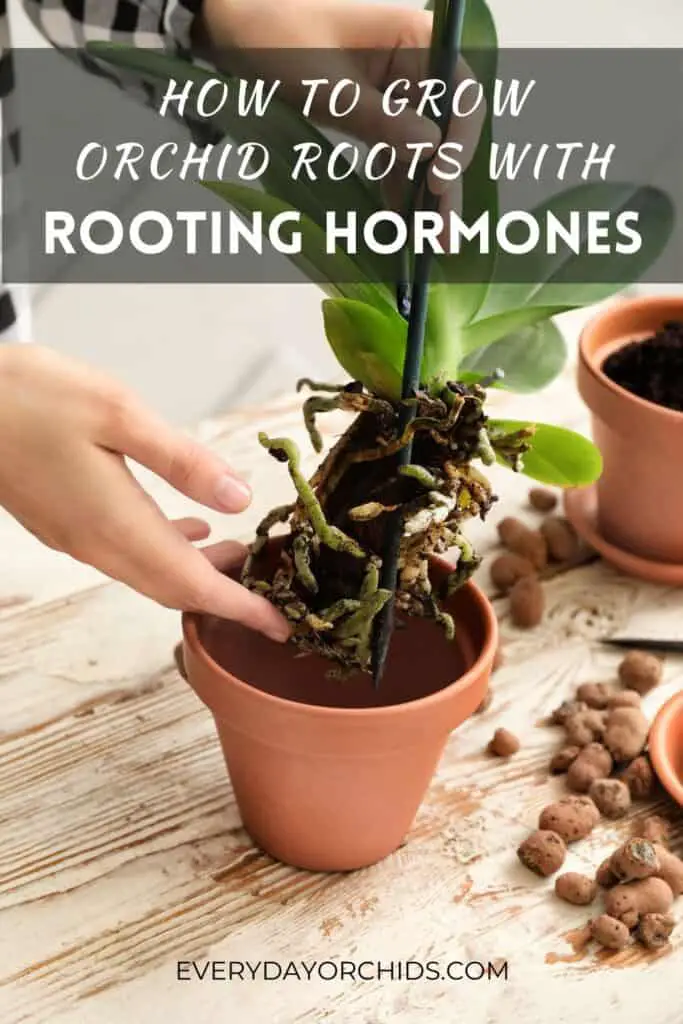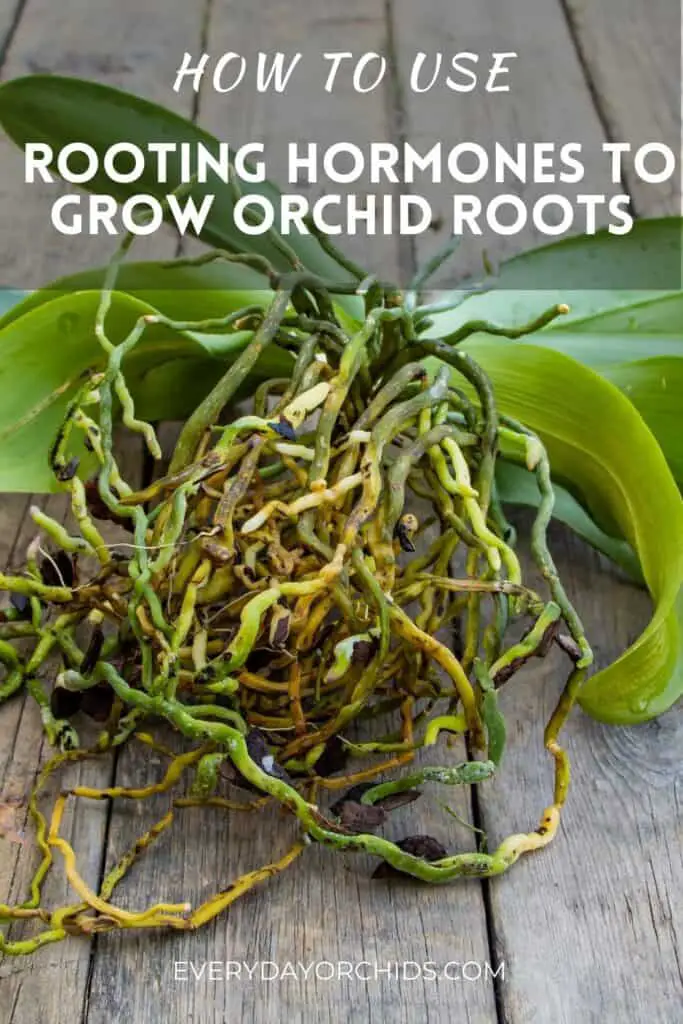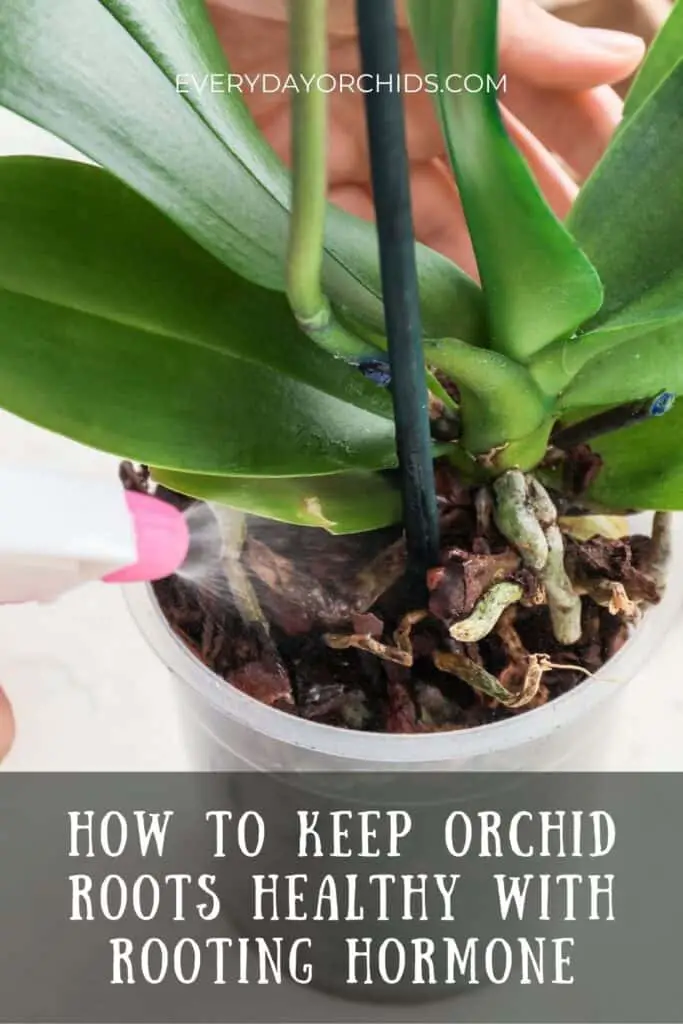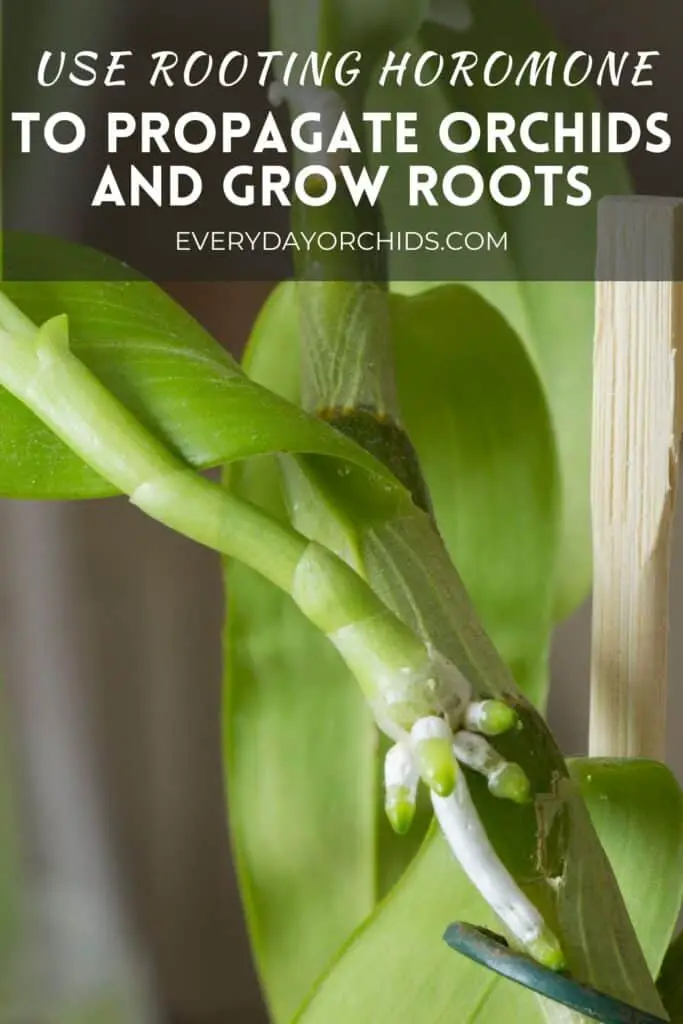Believe it or not, rooting hormone is a handy tool to have in your orchid care arsenal. It can be used for a number of different purposes, which I’ll go over below. Once you know how and when to use rooting hormone on your orchids, you may find yourself making this product a part of your routine orchid care.
Rooting hormone can be used on orchids to stimulate new root growth and maintain healthy roots. You can use it to propagate new orchids. It can also be used to help save an orchid that has lost the majority of its roots. Rooting hormone can also be used to help an orchid recover from the shock related to repotting and removal of rotted and dead roots.
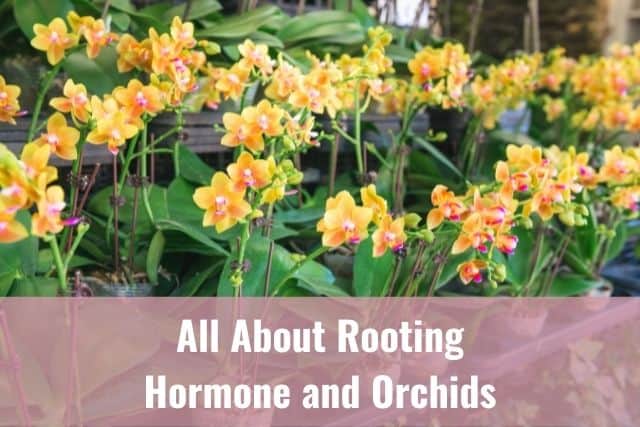
As you can see, there are a wide variety of uses for rooting hormone. However, there are also a lot rooting hormone products available out on the market. How do you choose the right one for your orchid? More importantly, how and when should you use these products on your orchids? I’ll go over the answers to both these questions and more below.
As an Amazon Associate I earn from qualifying purchases. Purchases made through affiliate links in this post may generate commissions at no additional cost to you. Thank you for your support!
Table of Contents
How Does Rooting Hormone Work On Orchids?

Rooting hormone works by stimulating growth using synthetic versions of auxin and cytokinins.
Auxin is a naturally occurring plant hormone. It promotes the growth of new roots and the branching of existing roots. In orchids, the branching of existing roots translates into old roots growing new root tips.
Normally, in plants, the presence of auxin and all of this growth stimulates the production of cytokinin. Cytokinin is another plant hormone. Its causes cell division in plants and more plant growth.
Rooting Hormone With Seaweed Or Algae
Some rooting hormones sold on the market are made with algae, kelp or seaweed. Instead of synthetic versions of plant hormones, they contain other ingredients to promote root growth. Namely, products with seaweed extract have a lot of vitamins, minerals and nutrients to encourage growth.
So, rather than using a synthetic rooting hormone, you can buy a rooting hormone containing seaweed or kelp extract as the main ingredient. This is a great natural, non-toxic option for your orchids.
In addition, many rooting hormones containing seaweed also have auxin, which will help stimulate plant growth. However, the levels of auxin will be lower in seaweed-based rooting hormones than in synthetic products.
Despite that, seaweed and kelp-based rooting hormones are still effective in triggering root growth and supporting root health in orchids. Many orchid growers actually prefer this natural product for use on their orchids.
In summary, seaweed and kelp-based rooting hormones are rich in amino acids, vitamins and nutrients that are great for orchids. Orchids can then use this boost of nutrition to grow orchid roots more quickly.
You’ll find that there is a wide variety of kelp-based or seaweed-based rooting hormone products available out there for purchase. I’ll make some recommendations further below, when I talk about when and how you would use rooting hormone on your orchids.
Why You Should Use Rooting Hormone On Orchids
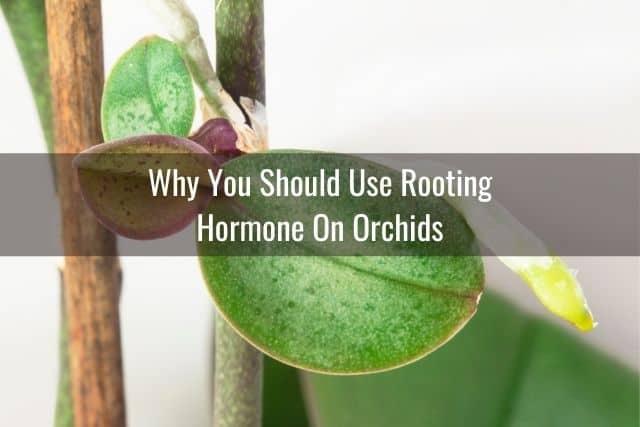
At the start of this article, I listed a few reasons why you might want to use rooting hormone on your orchids. I’ll go over each of those reasons in more detail. Hopefully this will help you decide whether or not you should use rooting hormone on your orchid.
Use Rooting Hormone To Grow New Roots
One of the most obvious benefits to using rooting hormone on orchids is that it grows new roots.
Orchids can, of course, grow roots just fine on their own without supplemental products. The benefit of rooting hormone is that it accelerates the process.
In the next section, I’ll go over how exactly you would prepare and use liquid rooting hormone to grow new roots.
Use Rooting Hormone For Orchid Propagation
Rooting hormone is actually commonly used in orchid propagation. In this case, you will find rooting hormone marketed as “keiki paste” or “keiki cloning hormone.” It may also be sold as “orchid cloning paste.”
There are times when you might want to propagate new orchids rather than wait and see if your orchid grows a keiki on its own.
Sometimes orchids never grow keikis on their own, so you can take matters into your own hands and use a rooting hormone.
In the next section, I’ll go over this process in more detail. You can also can check out this step-by-step guide to propagating new orchids for more information.
What Is A Keiki?
If you are wondering why orchid rooting hormone is sometimes called “keiki paste” or “keiki cloning hormone,” well, I’ll explain. “Keiki” is another name for a baby orchid, or an orchid plantlet, that grows from the original, mother orchid.
In Phalaenopsis orchids, a keiki can appear on one of the nodes along a flower spike. You may notice that instead of a flower bud, you see a little orchid with leaves and roots growing from the node.
On cane orchids such as Dendrobiums and Epidendrum orchids, keikis can appear on the nodes along the cane. This will be a little orchid shoot with leaves and roots growing along the middle of a cane.
In these cases, the keiki appears naturally and spontaneously on the orchid plant. Keiki orchids can grow for a number of reasons. Some orchids are more likely to grow keikis than others. Sometimes though, you may opt to use a stimulant such as a rooting hormone to trigger keiki growth.
For more information, check out this article about keiki orchids and how to care for them.
Use Rooting Hormone To Maintain Healthy Orchid Roots
You can use a rooting hormone to help support your orchid roots’ health. If you choose to use rooting hormone for maintenance purposes, be sure you select a liquid rooting hormone that you can mix with water. I would recommend one that is seaweed or kelp-based.
Whatever you do, don’t buy a rooting hormone powder or paste. Those types of product will not work for this purpose.
A popular liquid rooting hormone you can use is SuperThrive. It contains vitamins, minerals and kelp, a type of seaweed. It also contains a synthetic version of rooting hormone called 1-naphthyl acetic acid and vitamin B1, both of which will promote root growth.
SuperThrive is a popular product in hydroponics and can also be used if you happen to grow orchids in hydroponics.
To prepare this product for your regular potted orchids, dilute 1/4 teaspoon of SuperThrive in 1 gallon of water and mix well. You can apply it either weekly or monthly to your orchid roots. The soaking method for watering orchids would work best in this situation.
When used in this manner, it acts as a supplemental nutrient product for your orchids. You can either use it as a stand-alone additive or mix it with orchid fertilizer for an extra boost.
If you do use it with orchid fertilizer, then dilute both SuperThrive and orchid fertilizer together with water. Use the mixed product to feed and water your orchids at the same time.
If you want to try this, I would suggest doing it once and then observing your orchids to see how they respond before jumping into a weekly feeding schedule.
Another synthetic liquid rooting hormone you can use on your orchids is Hormex. Follow the product instructions for dilution and preparation recommendations. Use it to soak your orchid roots and keep them healthy and happy.
I go into more detail about how to water your orchids and how to fertilize your orchids elsewhere, so be sure to check out those resources.
When And How To Use Rooting Hormone On Orchids
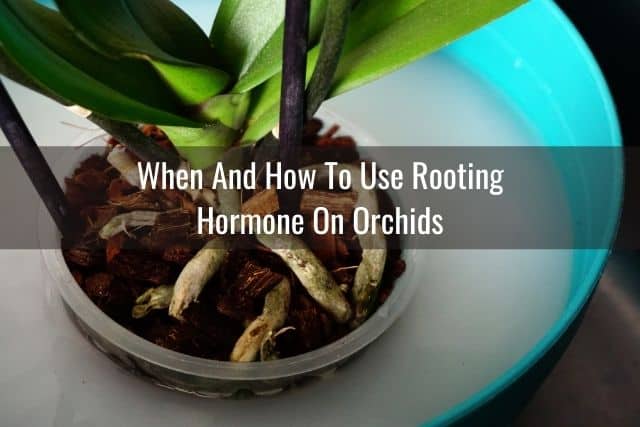
While there are many good reasons why you should use rooting hormone on your orchids, I do want to say that it is optional. In general, as long as your orchid is getting proper care and thriving, it probably will be fine without additional rooting hormone applied.
However, if you do want to try using rooting hormone to maintain healthy orchid roots, you’ll likely see faster growth in your orchid. You may be so pleased with the results that you may make rooting hormone a part of your routine orchid care.
That said, there are times when you should use rooting hormone on your orchid.
Orchid propagation is one situation in which rooting hormone is not only recommended, but necessary. It is also highly recommended to use rooting hormone after repotting and to save an orchid without roots.
For repotting and saving an orchid without roots, or even just to maintain healthy orchid roots, use a liquid rooting hormone with seaweed or kelp. For orchid propagation, use an orchid cloning paste.
Use Rooting Hormone After Repotting Your Orchids

Typically, when you repot your orchid, you also perform routine maintenance on your plant. This usually involves some sort of pruning of dead leaves, roots and other tissue. This is true whether you are dealing with root rot or dried, shriveled roots.
Partly because of the pruning and moving, repotting is generally a stressful time for orchids. Not only have some of the roots been pruned off, but the potting media and environment has changed.
During this time, the orchid roots have to adjust to a new, drier environment. They are exposed to less moisture and the orchid may lose additional roots during this adjustment period.
Applying rooting hormone will help support your orchid through this transition. It will encourage new root growth at a time when your orchid needs it the most. Rooting hormone will also help the orchid get established in the new potting media more quickly.
In this case, you will want to use a liquid rooting hormone, preferably one containing seaweed or kelp. The added nutrients, vitamins and minerals will help nourish your orchid and allow it recover more quickly. You can either prepare and use the liquid rooting hormone as outlined above in the SuperThrive section, or as described below in the CleanKelp example.
Use Rooting Hormone To Save An Orchid Without Roots
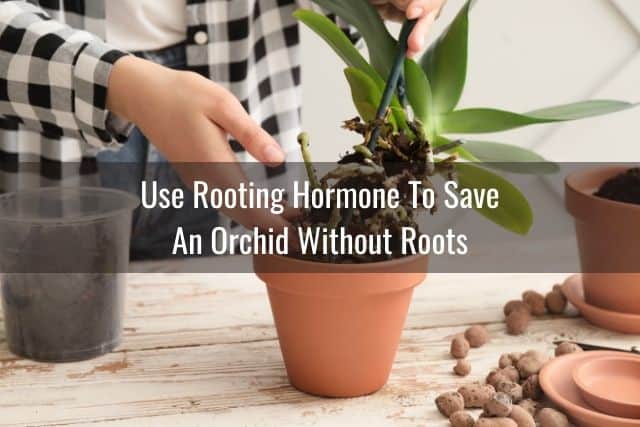
If your orchid has lost all of its roots due to root rot or dehydration, don’t throw away your orchid just yet. There is a way to save an orchid without roots.
I would recommend buying a liquid root hormone, such as CleanKelp. You can use it as either a foliar spray or soak your orchid roots in a bucket of this prepared solution when you water and feed your orchids.
To use CleanKelp as a foliar spray, mix 20ml of CleanKelp in a gallon of water. Pour this into a spray bottle and use it to spray the underside of orchid leaves. This will stimulate growth in the orchids.
To soak your orchid roots in this solution, dilute 1 teaspoon (30ml) of product and mix with 1 gallon of water. Use this prepared rooting hormone solution to feed your orchids each week. Simply soak the orchid roots in the solution for at least 15 minutes when you water your orchids. Watch as old orchid roots grow new root tips.
You can also dissolve orchid fertilizer into this bucket of water for an extra boost of nutrition and feed/water your orchid all at the same time. Just make sure that the rooting hormone product you are using is not a combo product with fertilizer already in it! If it does, you run the risk of burning your orchid roots.
Other popular root hormone products for orchids without roots include KLN. I would suggest storing these products in a cool, dry location to prevent mold growth and help the product last longer.
Use Rooting Hormone For Orchid Propagation
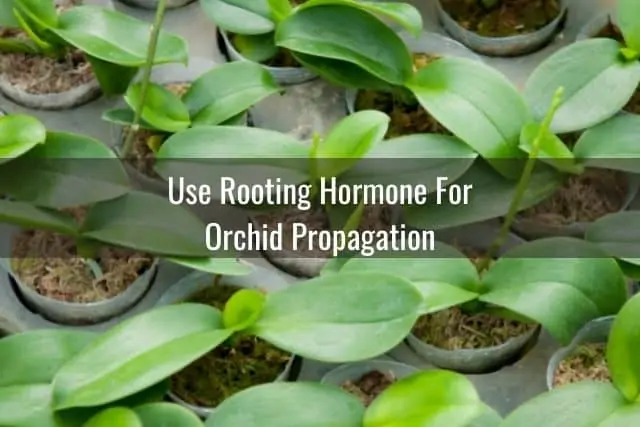
In order to propagate orchids such as Phalaenopsis orchids, you will need the help of a good rooting hormone. Rather than using a liquid rooting hormone, like in the two scenarios above, you will want to use a rooting hormone paste to propagate orchids. You need something that can stick to the orchid for an extended period of time.
Crazy Keiki Cloning Paste is one of the more popular rooting hormone pastes available for orchids. This cloning paste is water resistant and includes instructions on how to apply this to your orchids. This is probably my favorite cloning paste and I would recommend it for orchid propagation.
Elit Orchid Clone+ and Keiki Power Pro are two other rooting hormone products specifically made for orchid propagation.
To propagate orchids, choose an orchid that has at least one healthy flower spike and several nodes. Then follow the steps below to propagate multiple new orchids.
How To Use Cloning Paste To Propagate Orchids
I go into more detail about the process in my article about how to propagate orchids, but essentially, here are the basic steps:
- Carefully peel back the thin layer of tissue covering the orchid node. Use a sterilized knife or pair of tweezers to do this.
- Apply a pea-sized amount of rooting hormone to the exposed area.
When doing this, it is a good idea to apply rooting hormone, or orchid cloning paste, to several nodes. If you have an orchid with more than one flower spike, you can apply this to nodes on multiple spikes. Not every node will grow a keiki, so by using multiple nodes, you can increase your chances of success.
Once this is done, continue caring for your orchid as you normally would. Wait for keikis to grow along the orchid node. This can take up to 6 weeks.
When your orchid starts to show signs of keiki growth, congratulations! You have successfully used rooting hormone to grow new orchids.
As for what to do next, read this article about how to care for your orchid keiki. Among other things, you’ll learn when to separate the keiki from the mother orchid and the best way to do it.
It is also possible to use rooting hormone to grow new orchids on stem cuttings. If you would like to do this, you can learn more by reading about how to propagate Phalaenopsis orchids from stem cuttings.
Don’t Use Powdered Rooting Hormone On Orchids
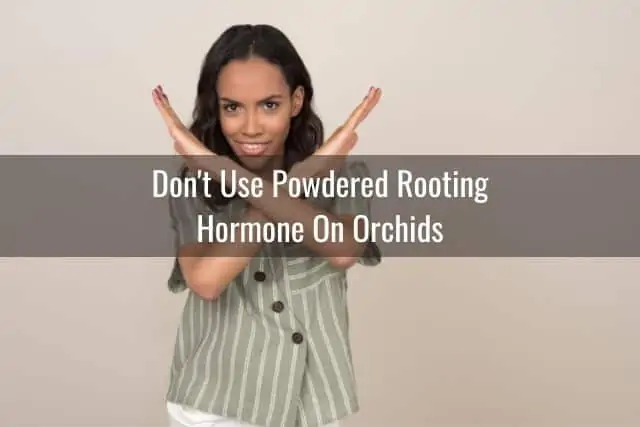
You may have noticed that I’ve recommended rooting hormone paste, or cloning paste, for propagating orchids. I’ve also recommended liquid rooting hormone, both with and without seaweed or kelp, for root health and growth.
However, I have not recommended buying rooting hormone powder. This was on purpose and for a couple of reasons.
Rooting hormone in the powder form is much stronger than the liquid form. You wouldn’t want to apply this directly to your orchid roots. Remember, for the liquid rooting hormone, you typically mix a small amount in a gallon of water, ensuring it is well diluted before use.
Rooting hormone powder will not stick to orchid roots or orchid nodes. There isn’t a great way to apply this to your orchids and keep it on long enough to generate an effect.
For example, say you trim your orchid roots and dip the cut ends in rooting hormone. Then you go on to repot your orchid and you arrange potting media around the roots. All this movement and friction will cause most of the rooting hormone powder to fall off. Whatever remains will be washed away during the next watering session, wasting your efforts.
For these reasons, it is much preferred to use a liquid rooting hormone and mix that with water. You can soak your orchid roots in this solution. A greater surface area of orchid roots will be exposed to rooting hormone, yielding a greater benefit. In addition, the long soaking time will allow the roots to better absorb the nutrients.
Long story short, save the powdered rooting hormone for plants that you plant in soil, and don’t use it on your orchids.
Final Thoughts
Rooting hormone is most commonly used to propagate new orchids. It also comes in handy when you want to stimulate your orchid to grow new or more roots. You can also use it on a regular basis to maintain the health of your orchid’s roots.
When choosing what kind of rooting hormone to use for your orchids, go for a rooting paste for propagation and a liquid rooting hormone for all other purposes. Healthy roots translate into a healthy orchid that will produce beautiful blooms. As such, do your best to take care of your orchid roots.
I hope this has helped and that you learned something new today. As always, happy orchid growing!
P.S. For more information, check out this informative article by the St. Augustine Orchid Society on root stimulators.
If you enjoyed this article, please pin it and share!
